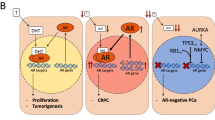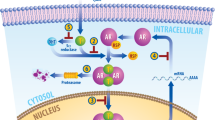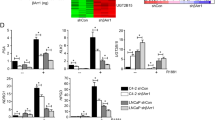Abstract
Since the original observations of Huggins and Hodges that prostate cancers are androgen dependent, androgen ablation therapy has been the gold standard for the treatment of advanced prostate cancer (CaP). Androgen receptor (AR) is believed to play critical roles in the development and progression of CaP. Treatment for neoadjuvant, adjuvant and recurrent disease all center on the regulation and manipulation of the androgen pathway, in which AR plays an integral role. Recent discoveries that frequent overexpression of ETS-related proto-oncogenes may be driven by AR as a consequence of common genomic rearrangements can hold the key towards the understanding of early phases of prostate cancer. Furthermore, AR function evolves as the cell changes towards a clinically androgen depletion independent state. Comprehension of AR function, regulation and abnormalities are increasingly refined towards the understanding of the role of AR in CaP, and in therapeutic applications. Development of future therapy for CaP will be aided by improving the knowledge of dysfunctions of AR and its network in prostate cancer. This review focuses salient features of AR and on the recent advances addressing AR dysfunctions in prostate cancer.
This is a preview of subscription content, access via your institution
Access options
Subscribe to this journal
Receive 4 print issues and online access
$259.00 per year
only $64.75 per issue
Buy this article
- Purchase on Springer Link
- Instant access to full article PDF
Prices may be subject to local taxes which are calculated during checkout

Similar content being viewed by others
References
Dehm SM, Tindall DJ . Molecular regulation of androgen action in prostate cancer. J Cell Biochem 2006; 99: 333–344.
Segawa T, Nau ME, Xu LL, Chilukuri RN, Makarem M, Zhang W et al. Androgen-induced expression of endoplasmic reticulum (ER) stress response genes in prostate cancer cells. Oncogene 2002; 21: 8749–8758.
Masuda K, Werner T, Maheshwari S, Frisch M, Oh S, Petrovics G et al. Androgen receptor binding sites identified by a GREF_GATA model. J Mol Biol 2005; 353: 763–771.
Gelmann EP . Molecular biology of the androgen receptor. J Clin Oncol 2002; 20: 3001–3015.
MacLean HE, Warne GL, Zajac JD . Localization of functional domains in the androgen receptor. J Steroid Biochem Mol Biol 1997; 62: 233–242.
Neckers L, Ivy SP . Heat shock protein 90. Curr Opin Oncol 2003; 15: 419–424.
Lee DK, Chang C . Molecular communication between androgen receptor and general transcription machinery. J Steroid Biochem Mol Biol 2003; 84: 41–49.
Lee DK, Chang C . Endocrine mechanisms of disease: expression and degradation of androgen receptor: mechanism and clinical implication. J Clin Endocrinol Metab 2003; 88: 4043–4054.
Lange CA, Gioeli D, Hammes SR, Marker PC . Integration of rapid signaling events with steroid hormone receptor action in breast and prostate cancer. Annu Rev Physiol 2006; PMID:17037979.
Rahman M, Miyamoto H, Chang C . Androgen receptor coregulators in prostate cancer: mechanisms and clinical implications. Clin Cancer Res 2004; 10: 2208–2219.
Edwards J, Bartlett JM . The androgen receptor and signal-transduction pathways in hormone-refractory prostate cancer. Part 2. Androgen-receptor cofactors and bypass pathways. BJU Int 2005; 95: 1327–1335.
Reddy GP, Barrack ER, Dou QP, Menon M, Pelley R, Sarkar FH et al. Regulatory processes affecting androgen receptor expression, stability, and function: Potential targets to treat hormone-refractory prostate cancer. J Cell Biochem 2006; 98: 1408–1423.
Gregory CW, He B, Johnson RT, Ford OH, Mohler JL, French FS et al. A mechanism for androgen receptor-mediated prostate cancer recurrence after androgen deprivation therapy. Cancer Res 2001; 61: 4315–4319.
Nishimura K, Ting HJ, Harada Y, Tokizane T, Nonomura N, Kang HY et al. Modulation of androgen receptor transactivation by gelsolin: a newly identified androgen receptor coregulator. Cancer Res 2003; 63: 4888–4894.
Rahman MM, Miyamoto H, Lardy H, Chang C . Inactivation of androgen receptor coregulator ARA55 inhibits androgen receptor activity and agonist effect of antiandrogens in prostate cancer cells. Proc Natl Acad Sci USA 2003; 100: 5124–5129.
Culig Z, Klocker H, Bartsch G, Steiner H, Hobisch A . Androgen receptors in prostate cancer. J Urol 2003; 170: 1363–1369.
Yang L, Xie S, Jamaluddin MS, Altuwaijri S, Ni J, Kim E et al. Induction of androgen receptor expression by phosphatidylinositol 3-kinase/Akt downstream substrate, FOXO3a, and their roles in apoptosis of LNCaP prostate cancer cells. J Biol Chem 2005; 280: 33558–33565.
Gamble SC, Chotai D, Odontiadis M, Dart DA, Brooke GN, Powell SM et al. Prohibitin, a protein downregulated by androgens, represses androgen receptor activity. Oncogene 2006; PMID:16964284.
Majumder S, Liu Y, Ford III OH, Mohler JL, Whang YE . Involvement of arginine methyltransferase CARM1 in androgen receptor function and prostate cancer cell viability. Prostate 2006; 66: 1292–1301.
Metzger E, Wissmann M, Yin N, Muller JM, Schneider R, Peters AH et al. LSD1 demethylates repressive histone marks to promote androgen-receptor-dependent transcription. Nature 2005; 437: 436–439.
Kim J, Jia L, Tilley WD, Coetzee GA . Dynamic methylation of histone H3 at lysine 4 in transcriptional regulation by the androgen receptor. Nucleic Acids Res 2003; 31: 6741–6747.
Jia L, Shen HC, Wantroba M, Khalid O, Liang G, Wang Q et al. Locus-wide chromatin remodeling and enhanced androgen receptor-mediated transcription in recurrent prostate tumor cells. Mol Cell Biol 2006; 26: 7331–7341.
Xu LL, Su YP, Labiche R, Segawa T, Shanmugam N, McLeod DG et al. Quantitative expression profile of androgen-regulated genes in prostate cancer cells and identification of prostate-specific genes. Int J Cancer 2001; 92: 322–328.
Horie-Inoue K, Bono H, Okazaki Y, Inoue S . Identification and functional analysis of consensus androgen response elements in human prostate cancer cells. Biochem Biophys Res Commun 2004; 325: 1312–1317.
Kim J, Coetzee GA . Prostate specific antigen gene regulation by androgen receptor. J Cell Biochem 2004; 93: 233–241.
Petrovics G, Liu A, Shaheduzzaman S, Furasato B, Sun C, Chen Y et al. Frequent overexpression of ETS-related gene-1 (ERG1) in prostate cancer transcriptome. Oncogene 2005; 24: 3847–3852.
Tomlins SA, Rhodes DR, Perner S, Dhanasekaran SM, Mehra R, Sun XW et al. Recurrent fusion of TMPRSS2 and ETS transcription factor genes in prostate cancer. Science 2005; 310: 644–648.
Marx J . Medicine. Fused genes may help explain the origins of prostate cancer. Science 2005; 310: 603.
Walsh P . Urological oncology: prostate cancer. J Urol 2006; 175: 1706–1710.
Wang J, Cai Y, Ren C, Ittmann M . Expression of variant TMPRSS2/ERG fusion messenger RNAs is associated with aggressive prostate cancer. Cancer Res 2006; 66: 8347–8351.
Cerveira N, Ribeiro FR, Peixoto A, Costa V, Henrique R, Jeronimo C et al. TMPRSS2-ERG gene fusion causing ERG overexpression precedes chromosome copy number changes in prostate carcinomas and paired HGPIN lesions. Neoplasia 2006; 8: 826–832.
Rochette-Egly C . Nuclear receptors: integration of multiple signalling pathways through phosphorylation. Cell Signal 2003; 15: 355–366.
Edwards J, Bartlett JM . The androgen receptor and signal-transduction pathways in hormone-refractory prostate cancer. Part 1: modifications to the androgen receptor. BJU Int 2005; 95: 1320–1326.
Nan B, Snabboon T, Unni E, Yuan XJ, Whang YE, Marcelli M . The PTEN tumor suppressor is a negative modulator of androgen receptor transcriptional activity. J Mol Endocrinol 2003; 31: 169–183.
Wu Z, Conaway M, Gioeli D, Weber MJ, Theodorescu D . Conditional expression of PTEN alters the androgen responsiveness of prostate cancer cells. Prostate 2006; 66: 1114–1123.
Chen Z, Trotman LC, Shaffer D, Lin HK, Dotan ZA, Niki M et al. Crucial role of p53-dependent cellular senescence in suppression of Pten-deficient tumorigenesis. Nature 2005; 436: 725–730.
Lei Q, Jiao J, Xin L, Chang CJ, Wang S, Gao J et al. NKX3.1 stabilizes p53, inhibits AKT activation, and blocks prostate cancer initiation caused by PTEN loss. Cancer Cell 2006; 9: 367–378.
Lin DL, Whitney MC, Yao Z, Keller ET . Interleukin-6 induces androgen responsiveness in prostate cancer cells through up-regulation of androgen receptor expression. Clin Cancer Res 2001; 7: 1773–1781.
Petre-Draviam CE, Cook SL, Burd CJ, Marshall TW, Wetherill YB, Knudsen KE . Specificity of cyclin D1 for androgen receptor regulation. Cancer Res 2003; 63: 4903–4913.
Woodson K, Tangrea JA, Pollak M, Copeland TD, Taylor PR, Virtamo J et al. Serum insulin-like growth factor I: tumor marker or etiologic factor? A prospective study of prostate cancer among Finnish men. Cancer Res 2003; 63: 3991–3994.
Gregory CW, Fei X, Ponguta LA, He B, Bill HM, French FS et al. Epidermal growth factor increases coactivation of the androgen receptor in recurrent prostate cancer. J Biol Chem 2004; 279: 7119–7130.
Xu LL, Shi Y, Petrovics G, Sun C, Makarem M, Zhang W et al. PMEPA1, an androgen-regulated NEDD4-binding protein, exhibits cell growth inhibitory function and decreased expression during prostate cancer progression. Cancer Res 2003; 63: 4299–4304.
Cha TL, Qiu L, Chen CT, Wen Y, Hung MC . Emodin down-regulates androgen receptor and inhibits prostate cancer cell growth. Cancer Res 2005; 65: 2287–2295.
Pajonk F, van Ophoven A, McBride WH . Hyperthermia-induced proteasome inhibition and loss of androgen receptor expression in human prostate cancer cells. Cancer Res 2005; 65: 4836–4843.
Santos AF, Huang H, Tindall DJ . The androgen receptor: a potential target for therapy of prostate cancer. Steroids 2004; 69: 79–85.
Wu CP, Gu FL . The prostate in eunuchs. Prog Clin Biol Res 1991; 370: 249–255.
Schatzl G, Madersbacher S, Haitel A, Gsur A, Preyer M, Haidinger G et al. Associations of serum testosterone with microvessel density, androgen receptor density and androgen receptor gene polymorphism in prostate cancer. J Urol 2003; 169: 1312–1315.
Massengill JC, Sun L, Moul JW, Wu H, McLeod DG, Amling C et al. Pretreatment total testosterone level predicts pathological stage in patients with localized prostate cancer treated with radical prostatectomy. J Urol 2003; 169: 1670–1675.
Chen SS, Chen KK, Lin AT, Chang YH, Wu HH, Chang LS . The correlation between pretreatment serum hormone levels and treatment outcome for patients with prostatic cancer and bony metastasis. BJU Int 2002; 89: 710–713.
Li R, Wheeler T, Dai H, Frolov A, Thompson T, Ayala G . High level of androgen receptor is associated with aggressive clinicopathologic features and decreased biochemical recurrence-free survival in prostate: cancer patients treated with radical prostatectomy. Am J Surg Pathol 2004; 28: 928–934.
Chen CD, Welsbie DS, Tran C, Baek SH, Chen R, Vessella R et al. Molecular determinants of resistance to antiandrogen therapy. Nat Med 2004; 10: 33–39.
Catalona WJ, Antenor JA, Roehl KA, Moul JW . Screening for prostate cancer in high risk populations. J Urol 2002; 168: 1980–1983 discussion 1983–1984..
Taplin ME, Rajeshkumar B, Halabi S, Werner CP, Woda BA, Picus J et al. Androgen receptor mutations in androgen-independent prostate cancer: Cancer and Leukemia Group B Study 9663. J Clin Oncol 2003; 21: 2673–2678.
Zhao XY, Malloy PJ, Krishnan AV, Swami S, Navone NM, Peehl DM et al. Glucocorticoids can promote androgen-independent growth of prostate cancer cells through a mutated androgen receptor. Nat Med 2000; 6: 703–706.
Sun C, Shi Y, Xu LL, Nageswararao C, Davis LD, Segawa T et al. Androgen receptor mutation (T877A) promotes prostate cancer cell growth and cell survival. Oncogene 2006; 25: 3905–3913.
Rokhlin OW, Taghiyev AF, Guseva NV, Glover RA, Chumakov PM, Kravchenko JE et al. Androgen regulates apoptosis induced by TNFR family ligands via multiple signaling pathways in LNCaP. Oncogene 2005; 24: 6773–6784.
Hara T, Miyazaki J, Araki H, Yamaoka M, Kanzaki N, Kusaka M et al. Novel mutations of androgen receptor: a possible mechanism of bicalutamide withdrawal syndrome. Cancer Res 2003; 63: 149–153.
Miyamoto H, Rahman MM, Chang C . Molecular basis for the antiandrogen withdrawal syndrome. J Cell Biochem 2004; 91: 3–12.
Bohl CE, Gao W, Miller DD, Bell CE, Dalton JT . Structural basis for antagonism and resistance of bicalutamide in prostate cancer. Proc Natl Acad Sci USA 2005; 102: 6201–6206.
Hwang DJ, Yang J, Xu H, Rakov IM, Mohler ML, Dalton JT et al. Arylisothiocyanato selective androgen receptor modulators (SARMs) for prostate cancer. Bioorg Med Chem 2006; 14: 6525–6538.
Author information
Authors and Affiliations
Corresponding authors
Rights and permissions
About this article
Cite this article
Richter, E., Srivastava, S. & Dobi, A. Androgen receptor and prostate cancer. Prostate Cancer Prostatic Dis 10, 114–118 (2007). https://doi.org/10.1038/sj.pcan.4500936
Received:
Revised:
Accepted:
Published:
Issue Date:
DOI: https://doi.org/10.1038/sj.pcan.4500936
Keywords
This article is cited by
-
Circulating tumor DNA in advanced prostate cancer: transitioning from discovery to a clinically implemented test
Prostate Cancer and Prostatic Diseases (2019)
-
The Genomics of Prostate Cancer: emerging understanding with technologic advances
Modern Pathology (2018)
-
SH003 induces apoptosis of DU145 prostate cancer cells by inhibiting ERK-involved pathway
BMC Complementary and Alternative Medicine (2016)
-
Regulation of several androgen-induced genes through the repression of the miR-99a/let-7c/miR-125b-2 miRNA cluster in prostate cancer cells
Oncogene (2014)
-
Characterization of tumor differentiation factor (TDF) and its receptor (TDF-R)
Cellular and Molecular Life Sciences (2013)



